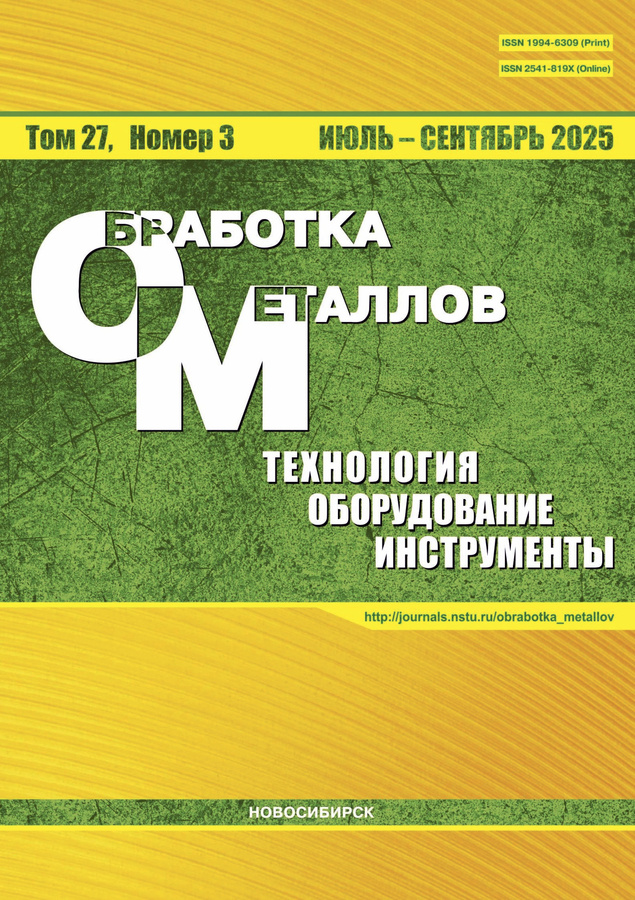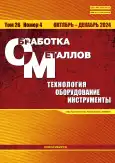Изготовление электродов-инструментов с оптимизированной конфигурациейдля копировально-прошивной электроэрозионной обработки методом быстрого прототипирования
- Авторы: Абляз Т.Р.1, Блохин В.Б.1, Шлыков Е.С.1, Муратов К.Р.1, Осинников И.В.1
-
Учреждения:
- Выпуск: Том 26, № 4 (2024)
- Страницы: 138-152
- Раздел: ОБОРУДОВАНИЕ. ИНСТРУМЕНТЫ
- URL: https://ogarev-online.ru/1994-6309/article/view/292554
- DOI: https://doi.org/10.17212/1994-6309-2024-26.4-138-152
- ID: 292554
Цитировать
Аннотация
Об авторах
Т. Р. Абляз
Email: lowrider11-13-11@mail.ru
ORCID iD: 0000-0001-6607-4692
канд. техн. наук, доцент, Пермский национальный исследовательский политехнический университет, Комсомольский проспект, 29, г. Пермь, 614990, Россия, lowrider11-13-11@mail.ru
В. Б. Блохин
Email: warkk98@mail.ru
ORCID iD: 0009-0009-2693-6580
Пермский национальный исследовательский политехнический университет, Комсомольский проспект, 29, г. Пермь, 614990, Россия, warkk98@mail.ru
Е. С. Шлыков
Email: Kruspert@mail.ru
ORCID iD: 0000-0001-8076-0509
канд. техн. наук, Пермский национальный исследовательский политехнический университет, Комсомольский проспект, 29, г. Пермь, 614990, Россия, Kruspert@mail.ru
К. Р. Муратов
Email: Karimur_80@mail.ru
ORCID iD: 0000-0001-7612-8025
доктор техн. наук, доцент, Пермский национальный исследовательский политехнический университет, Комсомольский проспект, 29, г. Пермь, 614990, Россия, Karimur_80@mail.ru
И. В. Осинников
Email: ilyuhaosinnikov@bk.ru
ORCID iD: 0009-0006-4478-3803
Пермский национальный исследовательский политехнический университет, Комсомольский проспект, 29, г. Пермь, 614990, Россия, ilyuhaosinnikov@bk.ru
Список литературы
- Predictive model of milling force for complex profile milling / X. Su, G. Wang, J. Yu, F. Jiang, J. Li, Y. Rong // The International Journal of Advanced Manufacturing Technology. – 2016. – Vol. 87. – P. 1653–1662. – doi: 10.1007/s00170-016-8589-1.
- Additive manufacturing of Nickel-based superalloy: optimization of surface roughness using integrated high-speed milling / D. Sommer, A. Safi, C. Esen, R. Hellmann // Proceedings of SPIE. – 2024. – Vol. 12876: Laser 3D Manufacturing XI. – doi: 10.1117/12.3000972.
- Influence of the sphero-cylindrical tool orientation angles on roughness under processing complex-profile surfaces / M.R. Gimadeev, A.V. Nikitenko, V.O. Berkun // Advanced Engineering Research. – 2023. – Vol. 23 (3). – P. 231–240. – doi: 10.23947/2687-1653-2023-23-3-231-240.
- Ho K.H., Newman S.T. State of the art electrical discharge machining (EDM) // International Journal of Machine Tools and Manufacture. – 2003. – Vol. 43 (13). – P. 1287–1300. – doi: 10.1016/S0890-6955(03)00162-7.
- Porwal R.K., Yadava V., Ramkumar J. Micro electrical discharge machining of micro-hole // Advanced Science Engineering and Medicine. – 2020. – Vol. 12 (11). – P. 1335–1339. – doi: 10.1166/asem.2020.2586.
- Rajurkar K.P., Sundaram M.M., Malshe A.P. Review of electrochemical and electrodischarge machining // Procedia CIRP. – 2013. – Vol. 6 (2). – P. 13–26. – doi: 10.1016/j.procir.2013.03.002.
- Rathod R., Kamble D., Ambhore N. Performance evaluation of electric discharge machining of titanium alloy – a review // Journal of Engineering and Applied Science. – 2022. – Vol. 69 (1). – P. 1–19. – doi: 10.1186/s44147-022-00118-z.
- Melchels F.P.W., Feijen J., Grijpma D.W. A review on stereolithography and its applications in biomedical engineering // Biomaterials. – 2010. – Vol. 31. – P. 6121–6130. – doi: 10.1016/j.biomaterials.2010.04.050.
- Continuous liquid interface production of 3D objects / J.R. Tumbleston, D. Shirvanyants, N. Ermoshkin, R. Janusziewicz, A.R. Johnson, D. Kelly, K. Chen, R. Pinschmidt, J.P. Rolland, A. Ermoshkin, E.T. Samulski, J.M. DeSimone // Science. – 2015. – Vol. 6228 (347). – P. 1349–1352. – doi: 10.1126/science.aaa2397.
- One-step volumetric additive manufacturing of complex polymer structures / M. Shusteff, A.E.M. Browar, B.E. Kelly, J. Henriksson, T.H. Weisgraber, R.M. Panas, N.X. Fang, C.M. Spadaccini // Science Advances. – 2017. – Vol. 3 (12). – P. 1–7. – doi: 10.1126/sciadv.aao5496.
- Layerless fabrication with continuous liquidinterface production / R. Janusziewicza, J.R. Tumblestonb, A.L. Quintanillac, S.J. Mechama, J.M. DeSimonea // Proceedings of the National Academy of Sciences. – 2016. – Vol. 113 (42). – P. 1–6. – doi: 10.1073/pnas.1605271113.
- Rapid multi-material 3D printing with projection micro-stereolithography using dynamic fluidic control / D. Han, C. Yang, N.X. Fangb, H. Lee // Additive Manufacturing. – 2019. – Vol. 27 (17). – P. 606–615. – doi: 10.1016/j.addma.2019.03.031.
- Jigang H., Qin Q., Jie W. A review of stereolithography: processes and systems // Processes. – 2020. – Vol. 8 (9). – P. 1–16. – doi: 10.3390/pr8091138.
- Polymers for 3D printing and customized additive manufacturing / S.C. Ligon, R. Liska, J. Stampfl, M. Gurr, R. Mu?lhaupt // Chemical Reviews. – 2017. – Vol. 117 (15). – doi: 10.1021/acs.chemrev.7b00074.
- Stansbury J.W., Idacavage M.J. 3D printing with polymers: challenges among expanding options and opportunities // Dental Materials. – 2016. – Vol. 32 (1). – P. 54–64. – doi: 10.1016/j.dental.2015.09.018.
- D printing of polymer matrix composites: a review and prospective / X. Wang, M. Jiang, Z. Zhou, J. Gou, D. Hui // Composites, Part B: Engineering. – 2017. – Vol. 110. – P. 442–458. – doi: 10.1016/j.compositesb.2016.11.034.
- Golabczak A., Konstantynowicz A., Golabczak M. Mathematical modelling of the physical phenomena in the interelectrode gap of the EDM process by means of cellular automata and field distribution equations // Experimental and Numerical Investigation of Advanced Materials and Structures. – Cham: Springer, 2013. – P. 169–184. – doi: 10.1007/978-3-319-00506-5_11.
- Quantitative analysis of bubble size and electrodes gap at different dielectric conditions in powder mixed EDM process / A. Kumar, A. Mandal, A.R. Dixit, D.K. Mandal // The International Journal of Advanced Manufacturing Technology. – 2020. – Vol. 4 (1). – P. 1–11. – doi: 10.1007/s00170-020-05189-x.
- Using rapid prototyping technologies for creating implants with cellular structure / P.N. Kilina, V.P. Vasilyuk, E.A. Morozov, A.M. Khanov, L.D. Sirotenko // Biosciences Biotechnology Research Asia. – 2015. – Vol. 12 (2). – P. 1691–1698. – doi: 10.13005/bbra/1832.
- Real-space wigner-seitz cells imaging of potassium on graphite via elastic atomic manipulation / F. Yin, P. Koskinen, S. Kulju, J. Akola, R.E. Palmer // Scientific Reports. – 2015. – Vol. 5 (1). – P. 1–5. – doi: 10.1038/srep08276.
- Cho Y., Lee I., Cho D.W. Laser scanning path generation considering photopolymer solidification in micro-stereolithography // Microsystem Technologies. – 2005. – Vol. 11 (2). – P. 158–167. – doi: 10.1007/s00542-004-0468-2.
Дополнительные файлы







